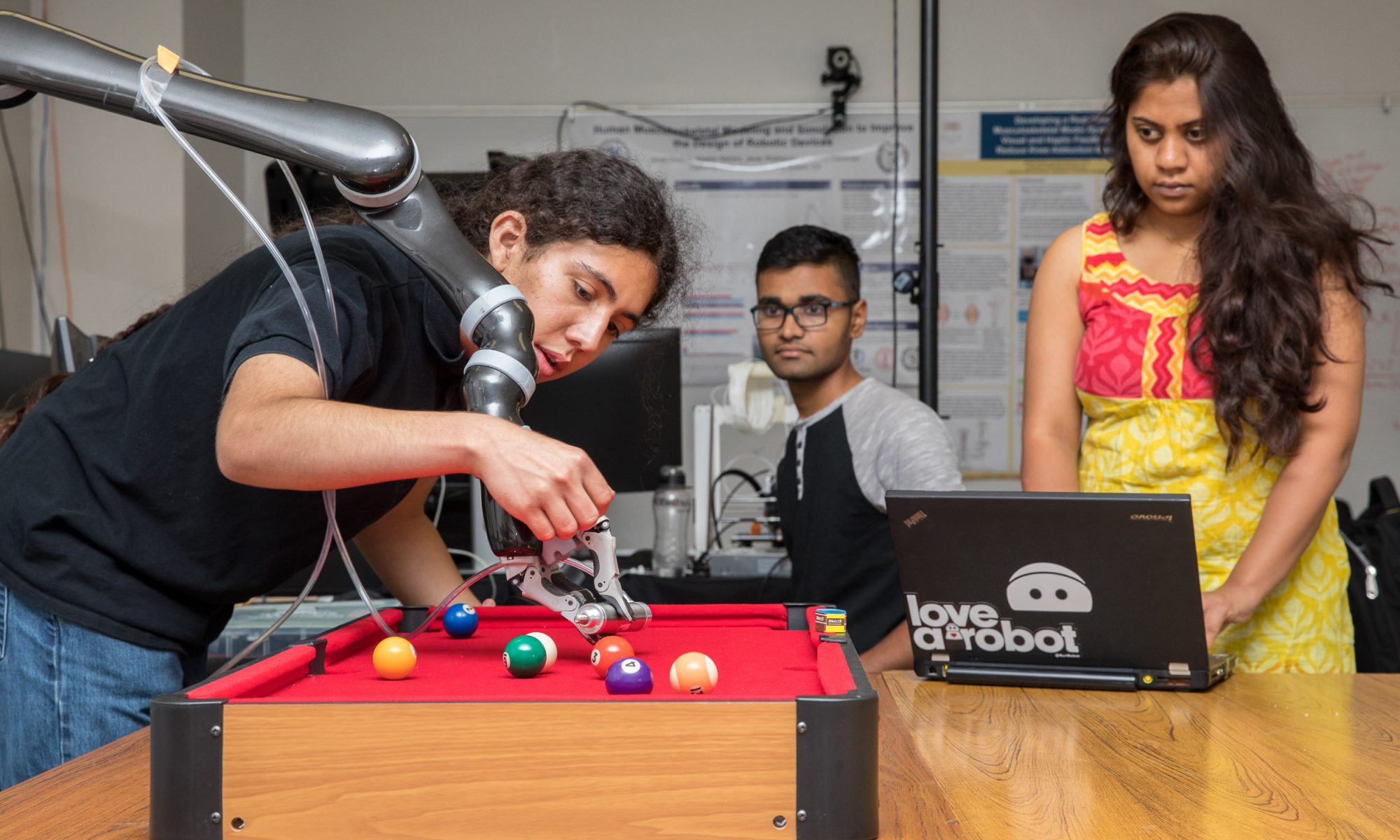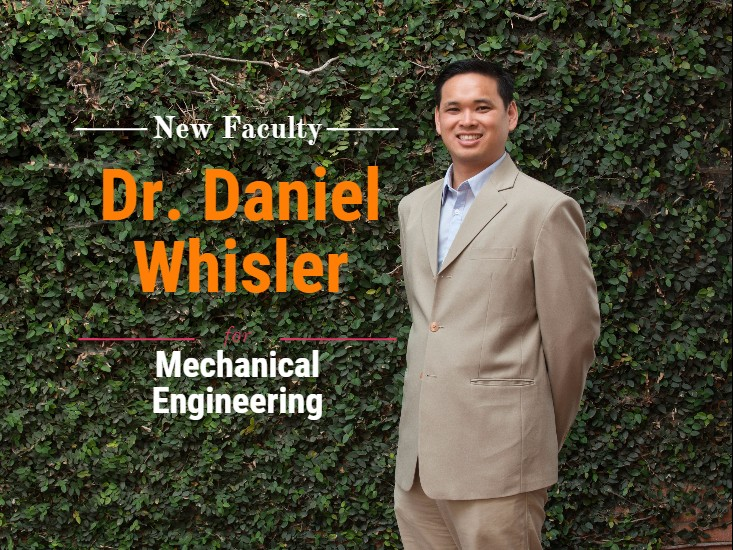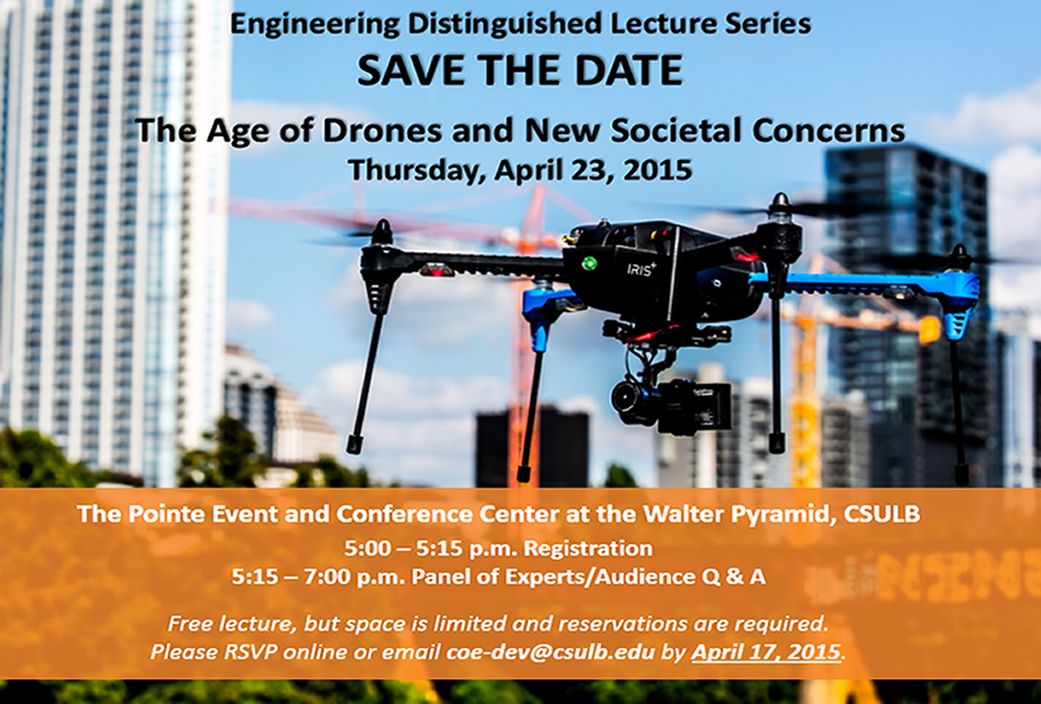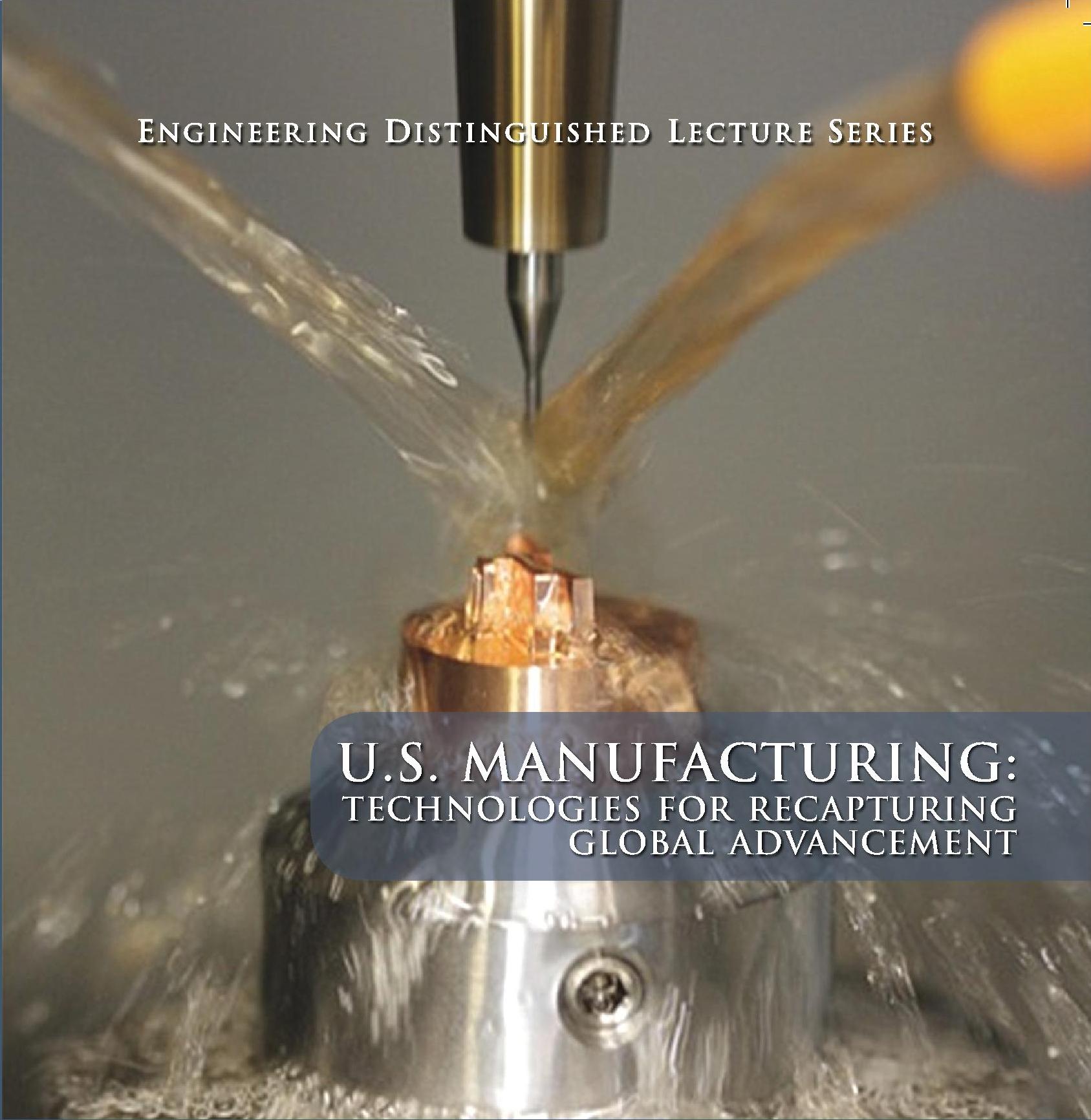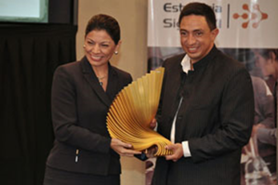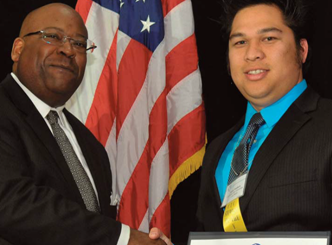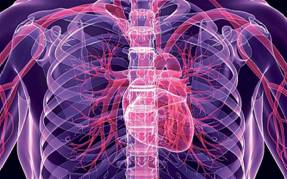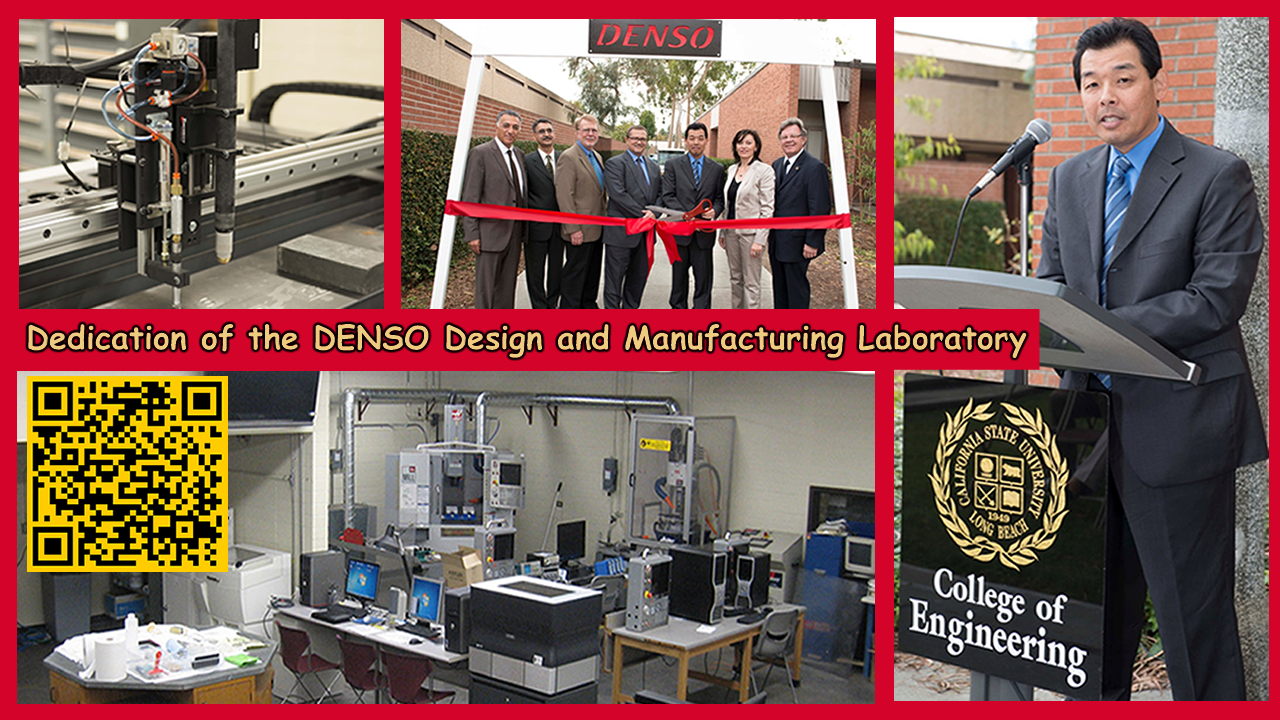COE Welcomes New Faculty
Elements of Change: Sept. 9
The Age of Drones
by Engineering Distinguished Lecture Series @ the College of Engineering (COE)
While drones have been widely used since the 1960’s during the Vietnam War, they really revolutionized warfare during the recent Middle East conflicts. We saw drones take on roles in both surveillance and strike. In addition, we saw everything from back packable small RC like models, the predator family of strike systems, and ship based vertical systems such as Fire Scout, to the large high flying long endurance Global Hawk. Not only has our military found practical and cost effective use of these autonomous aircrafts, but commercial entities such as Google and Amazon are looking at how they can help their businesses as well. Add to that a whole host of civil applications such as police forces, security systems (including pipeline surveillance), Homeland Security and Border Patrol. Last but not least, is the neighbor next door who just bought a quad copter and is flying it over your backyard swimming pool.
Scholarships Available for Engineering Students
by College of Engineering (COE) @ CSULB
Scholarships for Engineering Students. The College of Engineering offers over 100 scholarship opportunities for engineering majors ranging from $500-$2,500.
Applications and more information about the scholarships can be found at the CSULB Center for Scholarship links listed below. Applications must be turned in person to the Center for Scholarship Information (USU, Room 238). Deadline, Thursday, February 26, 2015 at 4:00p.m.
U.S. Manufacturing: Technologies for Recapturing Global Advancement
Did you know that if the top 500 U.S.-based manufacturing companies were counted as an independent nation, their total revenue would rank them as the third largest economy in the world! Yet, the US manufacturing sector has experienced substantial job losses at an alarming rate over the past two decades. Since the historical peak in the late 1970s, fewer and fewer jobs have been created in the manufacturing sector. In fact employment in manufacturing is now at its lowest since 1950.
Juan Chaves, Recipient of Costa Rica’s Highest Technology Honors
By Todd Howard
Juan Chaves (MS in Electrical Engineering, 2009) is the recipient of Costa Rica’s two highest technology honors—the Jorge Manuel Dengo Award from the organization Strategy XXI Century, and the Clodomiro Picado Twight Technology Award from the Ministry of Science and Technology. He was presented with both awards by Costa Rican President Laura Chinchilla.
Chaves serves as the director of the Nanotechnology Laboratory at the Instituto Technologico de Costa Rica, which is the nation’s leading university of engineering and science. His laboratory is the most advanced and well-funded nanotechnology laboratory in Latin America, and he is regarded as a leading authority in this immense multidisciplinary field.
Nanotechnology, with its dizzying range of potential applications, is poised to change the world significantly in the coming decades. From steel that is hundreds of times stronger and lighter than that of today, to microscopic-sized circuit boards with processing speeds beyond our wildest imaginings, to cures for scores of illnesses—the race is on to bring the near limitless possibilities of nanotechnology to fruition in the twenty-first century.
Chaves received his country’s top technology honors for the groundbreaking graduate research that he conducted at CSULB in the use of carbon “nanotubes” as an alternative to pharmaceutical antibiotics for stopping bacterial infections. This graduate research project, which was supervised by Chaves’ graduate advisor, Dr. Tulin Mangir, began as an exploration into electrical engineering applications of nanomaterials, but Chaves was inspired to move into the arena of biomedical applications after witnessing an unexpected phenomenon in the laboratory.
“I benefited from National Science Foundation funding to develop interconnections for computer devices using carbon nanotubes, and Dr. Mangir and I were using bacteria to clean these nanotubes,” says Chaves. “I saw the bacteria reacting to the nanotubes in some very intriguing ways, and it became evident to me that nanomaterials could serve as highly effective antibiotics that function through mechanical rather than chemical means.”
Such nanotechnology innovations were first theorized in the late 1950s by Nobel Prize-winning physicist Richard Feynman. He described a process in which scientists would one day be able to manipulate the individual atoms and molecules of virtually any material, and that by so doing they could imbue these materials with exponentially enhanced strength, electrical conductivity, etc. It wasn’t until the 1980s that specialized microscopes would be developed that would enable researchers to begin to view materials at the “nanoscale” (a sheet of newspaper is about 100,000 nanometers thick), and it has taken another quarter century for innovations such as Chaves’ to begin to emerge.
It is now evident that nanotechnology’s potential for impacting a nation’s economy will soon be on par with that of the Industrial Revolution or the Information Age. In 2003, the National Science Foundation predicted that nanotechnology would become a trillion-dollar industry within the next two decades. In response, Congress has enacted legislation that seeks to ensure U.S. leadership in this industry by requiring all federal agencies to strategically coordinate their nanotechnology research. Other highly industrialized nations are taking similar measures in an effort to stake out their shares of the global marketplace.

However, nanotechnology is also providing enormous opportunities to developing nations, as evidenced by the fact that Chaves’ work at the Instituto Technologico is positioning Costa Rica as a major exporter of this technology. “We’re seizing this opportunity to shape the future rather than waiting for others to create it and export it to Costa Rica,” says Chaves. “We’re developing nanotechnologies in niches that other countries aren’t actively exploring yet—particularly in agriculture. Costa Rica is an agricultural country, and we are well-positioned for developing technology that adds value to our own agricultural products on the international market and for licensing this technology to other countries as well.”
Award-Winning Ph.D. Student Jeremy Bonifacio’s Healthy Ambition
By Todd Howard
Engineering Ph.D. student Jeremy Bonifacio is distinguishing himself on the national stage as an innovator of high-tech solutions to longstanding environmental and public-health issues. Last year, he traveled to the Transportation Research Board’s annual conference in Washington D.C. to receive the METRANS Transportation Center’s “Student of the Year” award as well as a certificate of commendation from the U.S. Department of Transportation for his academic excellence and research in the reduction of airborne pollution.
A student in the “Engineering and Industrial Applied Math” doctoral program that is a joint endeavor between the College of Engineering and Claremont Graduate University, Bonifacio’s research in Fluid Dynamics is creating technologies that disperse indoor and outdoor pollutants before they can reach dangerously high levels of concentrations, as well as biomedical instruments for treating pollution-related illnesses. “The number of people who are getting sick from airborne pollutants is on the rise in developed and developing nations alike,” says Bonifacio. “There is urgent need for a comprehensive range of solutions.” Bonifacio recently served as the student team leader on a $1.8 million joint research endeavor between CSULB and the Port of Los Angeles that developed “seawater scrubber” technology for reducing the high concentrations of diesel particulate matter that are emitted from oceangoing vessels. The project’s principle investigator was Dr. Hamid Rahai, Bonifacio’s PhD advisor.
In addition to his research in Fluid Dynamics, Bonifacio is developing biomedical technology that holds the promise of providing more accurate diagnoses and targeted treatment of pollution-related illnesses such as respiratory infections, heart disease, and lung cancer. He presently teaches Aerodynamics Laboratory classes in CSULB’s Department of Mechanical and Aerospace Engineering, and is preparing for a career as a consultant in the field of environmental pollutants and as an entrepreneur in the field of biomedical technologies.
Engineering for the Body: Reproducing Body Functions
Human biologists, computer scientists and engineers are teaming to advance neuroscience toward achieving yet another one of NAE’s Grand Challenges, namely, understanding the complex network we call brain. Modern noninvasive methods can simultaneously measure the activity of many brain cells. Comprehension of how the brain works will enable engineers to simulate its activities, leading to deeper insights about how and why the brain works and fails.
Dedication of the DENSO Design and Manufacturing Laboratory
Recognizing the DENSO Corporation’s continuous and generous support of the College of Engineering, officials at CSULB dedicated the newly named DENSO Design and Manufacturing Laboratory in a ribbon-cutting ceremony on Nov. 15, 2013. DENSO is a leading global supplier of advanced automotive technology, systems and components in the areas of thermal, powertrain control, electronics and information and safety, and its ongoing support has been instrumental in defining the college’s presence in the area of design and manufacturing.
“The College of Engineering wants to educate the best, most highly qualified students who will enter the work force and be able to immediately support the mission of their employers,” says Forouzan Golshani, Dean of the College of Engineering. “DENSO has been phenomenal in enabling us to educate students on modern equipment and up-to-date technology.”
CSULB Interim President Donald Para was also on hand to comment on Denso’s substantial support of the College of Engineering. “The mission of Cal State Long Beach centers on student success. We graduate students who are well-prepared for their chosen careers. For this campus to continue to realize this goal, we need corporate and community partners who provide a critical edge in our student’s education. We are honored and very grateful that DENSO continues to be a significant partner for the College of Engineering in providing a high quality education for our students.”
Through the DENSO Foundation, the company donates between $25,000 and $50,000 annually in support of the College of Engineering’s student activities, its lecture series, its Innovation Challenge competition, and other essential endeavors. The newly named lab provides students with a place to learn computer-aided design, manufacturing and non-destructive testing, as well as such cutting-edge fields as additive manufacturing, which involves making three-dimensional solid objects of virtually any shape from a digital model.
“In addition to enabling our students to acquire individual design and manufacturing skills, the DENSO Lab gives them the opportunity to learn to set up economical and efficient manufacturing processes, and this holds important implications for our region’s manufacturing industry and economy,” says Golshani. “There is a push by the federal government to bring manufacturing back to the US, and this lab is enabling us to produce engineers who can help restore our manufacturing sector to its former glory.”
